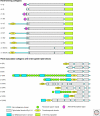The collagen family
- PMID: 21421911
- PMCID: PMC3003457
- DOI: 10.1101/cshperspect.a004978
The collagen family
Abstract
Collagens are the most abundant proteins in mammals. The collagen family comprises 28 members that contain at least one triple-helical domain. Collagens are deposited in the extracellular matrix where most of them form supramolecular assemblies. Four collagens are type II membrane proteins that also exist in a soluble form released from the cell surface by shedding. Collagens play structural roles and contribute to mechanical properties, organization, and shape of tissues. They interact with cells via several receptor families and regulate their proliferation, migration, and differentiation. Some collagens have a restricted tissue distribution and hence specific biological functions.
Figures




References
-
- Amenta PS, Scivoletti NA, Newman MD, Sciancalepore JP, Li D, Myers JC 2005. Proteoglycan-collagen XV in human tissues is seen linking banded collagen fibers subjacent to the basement membrane. J Histochem Cytochem 53: 165–176 - PubMed
-
- Avery NC, Bailey AJ 2006. The effects of the Maillard reaction on the physical properties and cell interactions of collagen. Pathol Biol 54: 387–395 - PubMed
-
- Bader HL, Keene DR, Charvet B, Veit G, Driever W, Koch M, Ruggiero F 2009. Zebrafish collagen XII is present in embryonic connective tissue sheaths (fascia) and basement membranes. Matrix Biol 28: 32–43 - PubMed
-
- Banos CC, Thomas AH, Kuo CK 2008. Collagen fibrillogenesis in tendon development: Current models and regulation of fibril assembly. Birth Defects Res C Embryo Today 84: 228–244 - PubMed
Publication types
MeSH terms
Substances
LinkOut - more resources
Full Text Sources
Other Literature Sources
Medical
